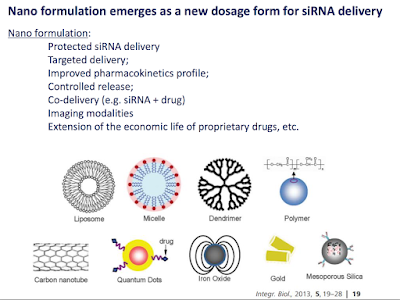Week 8 | Nanotechnology + Art
Nanotechnology
has always been an elusive subject to me. The first thing that would come to
mind when I heard about nanotechnology was tiny computer parts. This is not entirely
incorrect, but it certainly does not encompass all that nanotechnology is. The
impact of this “new science” extends to fields such as chemistry, engineering,
computing, communications, food science, and art. (Vesna) After reading "The
Nanomeme Syndrome", I realized the reason I have trouble visualizing what nanotechnology
is, is because it is inherently hard to do so. (Gimzeski and Vesna) How do you
make sense of what you cannot see? In the PBS documentary, “Making Stuff:
Smaller”, Frances Ross uses pizza as a metaphor to help people visualize
nanowires, which are transistors that are layered vertically to prevent short
circuiting. Creating tangible analogies like these will combat the problems
that may arise when trying to visualize nanotechnology as Vesna suggests.
| From Huan Meng's Lecture on Drug Delivery using Nanotechnology |
As a
biochemistry major, I am most excited by the use of nanotechnology in science. Recently,
a guest lecturer presented in my biology class on "Dosage Form Design:
Pharmaceutical and Formulation Considerations –Emerging formulation using
nanotechnology". His presentation was the first time I learned about the use
of nanotechnology in drug delivery, specifically. When creating a drug one must
consider its solubility and stability. Often it can be difficult to deliver a
drug directly to the target. Nanostructures, like micelles or scaffolds, are
created to facilitate this process.
 |
| DNA-origami strategies for drug delivery |
Furthermore,
Dr. Gimzeski introduced the self-assembly of nanoparticles, which is important
especially in medical applications. For instance, micelles organize based on
solubility and are used to encapsulate a drug and deliver it to its target. Nanoparticles
function within a cell on a nano-scale, thus it may not be possible to construct
them outside of the body. Recent efforts to create self-organizing
nanoparticles led to a new technique: Nano-origami. Nano-scientists utilize the
ancient Japanese art form to study how nanoparticles can fold. In this way,
scientists innovatively use art to push the boundaries of this developing
field.
Finally, on a nanoscale, light is reflected off of nanostructures differently than what we see. Nanophotonics is the study of this phenomenon which gives the blue morpho butterfly its iridescent blue color. This science is already utilized to create non-toxic pigmentation in our food. (Drake) Nanophotonics and other branches of nanoscience serve as new media for artists, which again reflects the collaboration of artists and scientists.
 |
| Nanoparticle folding inspired by origami |
 |
| Biomimetic iridescent berries (nanotech in our food) |
Drake, Nadia. "Weird Nanophotonic Materials Bend and Trap Light to Make Crazy Colors." Wired. Conde Nast, 13 Nov. 2013. Web. 26 May 2017. <https://www.wired.com/2013/11/weird-nanophotonic-materials/>
Gimzeski, Jim. "Nanotech for Artists Part 5." YouTube, 21 May 2012. Web. 26 May 2017. <https://www.youtube.com/watch?v=4OWc8nmHJmY>.
Gimzeski, Jim, and Victoria Vesna. "The Nanomeme Syndrome: Blurring of fact & fiction in the construction of a new science." N.p., n.d. Web. 24 May 2017.
Jude, Deborah L. "Engineering undergrads use DNA origami to target cancer." University of California. UC San Diego, 06 Mar. 2017. Web. 24 May 2017. <https://www.universityofcalifornia.edu/news/engineering-undergrads-use-dna-origami-target-cancer>.
"Making Stuff: Smaller." PBS. Public Broadcasting Service, 21 Aug. 2013. Web. 24 May 2017. <http://www.pbs.org/wgbh/nova/tech/making-stuff.html#making-stuff-smaller>
Jude, Deborah L. "Engineering undergrads use DNA origami to target cancer." University of California. UC San Diego, 06 Mar. 2017. Web. 24 May 2017. <https://www.universityofcalifornia.edu/news/engineering-undergrads-use-dna-origami-target-cancer>.
"Making Stuff: Smaller." PBS. Public Broadcasting Service, 21 Aug. 2013. Web. 24 May 2017. <http://www.pbs.org/wgbh/nova/tech/making-stuff.html#making-stuff-smaller>
Meng, Huan. "Dosage Form Design: Pharmaceutical and Formulation Considerations --Emerging formulation using nanotechnology." Guest Lecture. UCLA, Los Angeles. 24 May 2017. Lecture.



I really like how you connected what we learned in class to what you learn in your other classes/your major.I had no idea that nano-scientists applied origami in studying nanoparticles. What benefits have been found by studying origami in the folding of nanoparticles? In particular, are there any recent discoveries that suggest certain origami folds in nanoparticles lead to a more effective treatment in medicine/ whatever usage of nanoparticles?
ReplyDelete